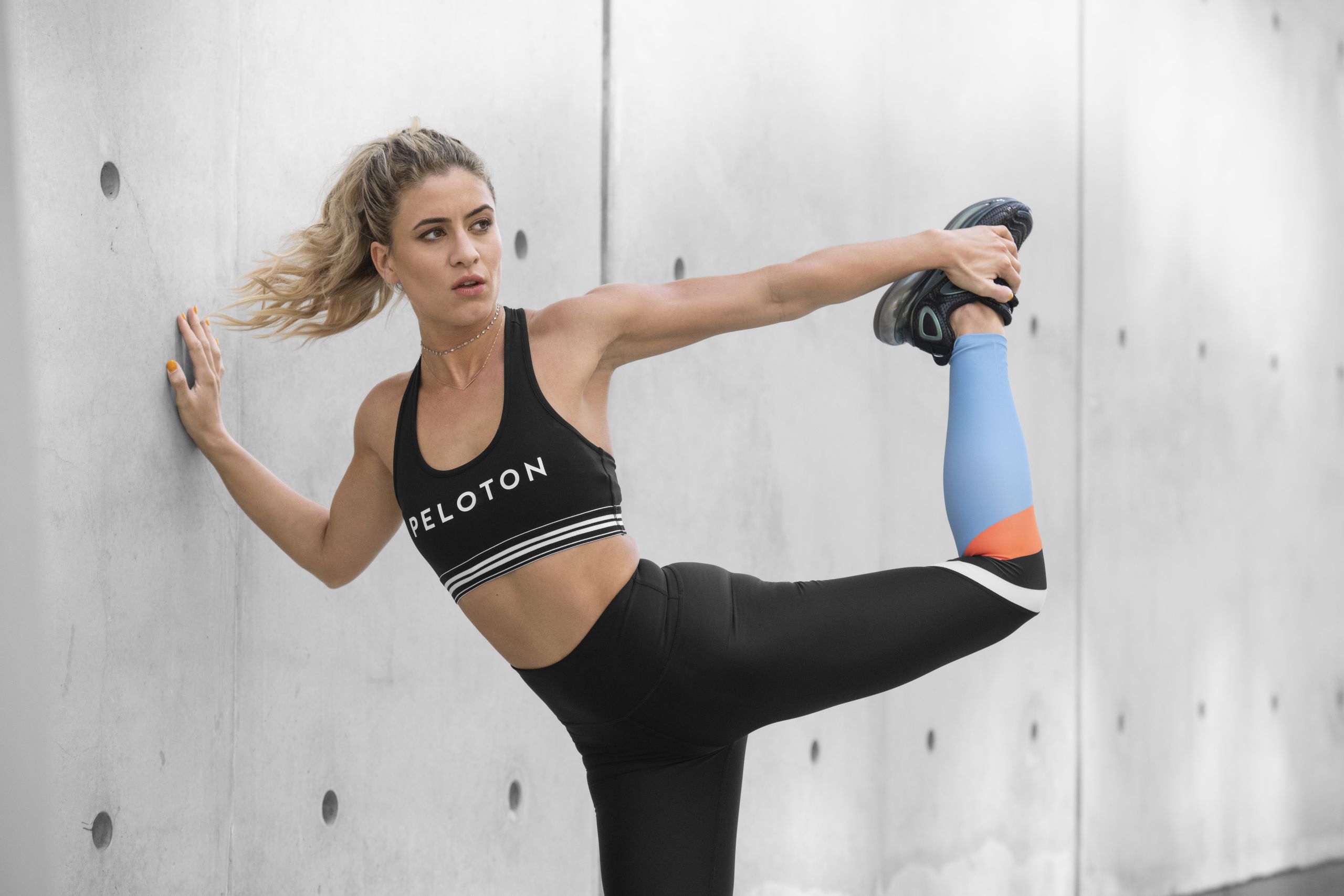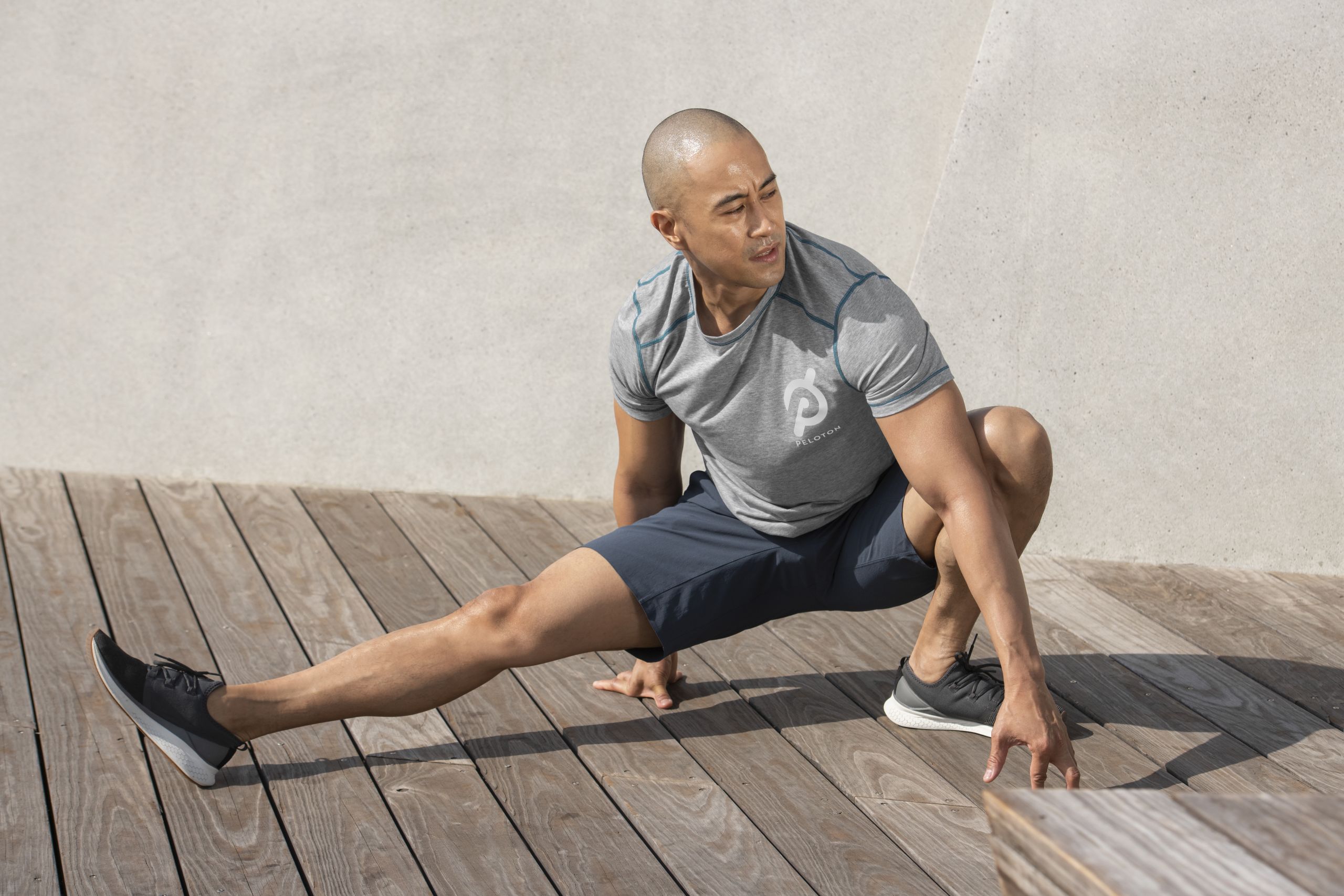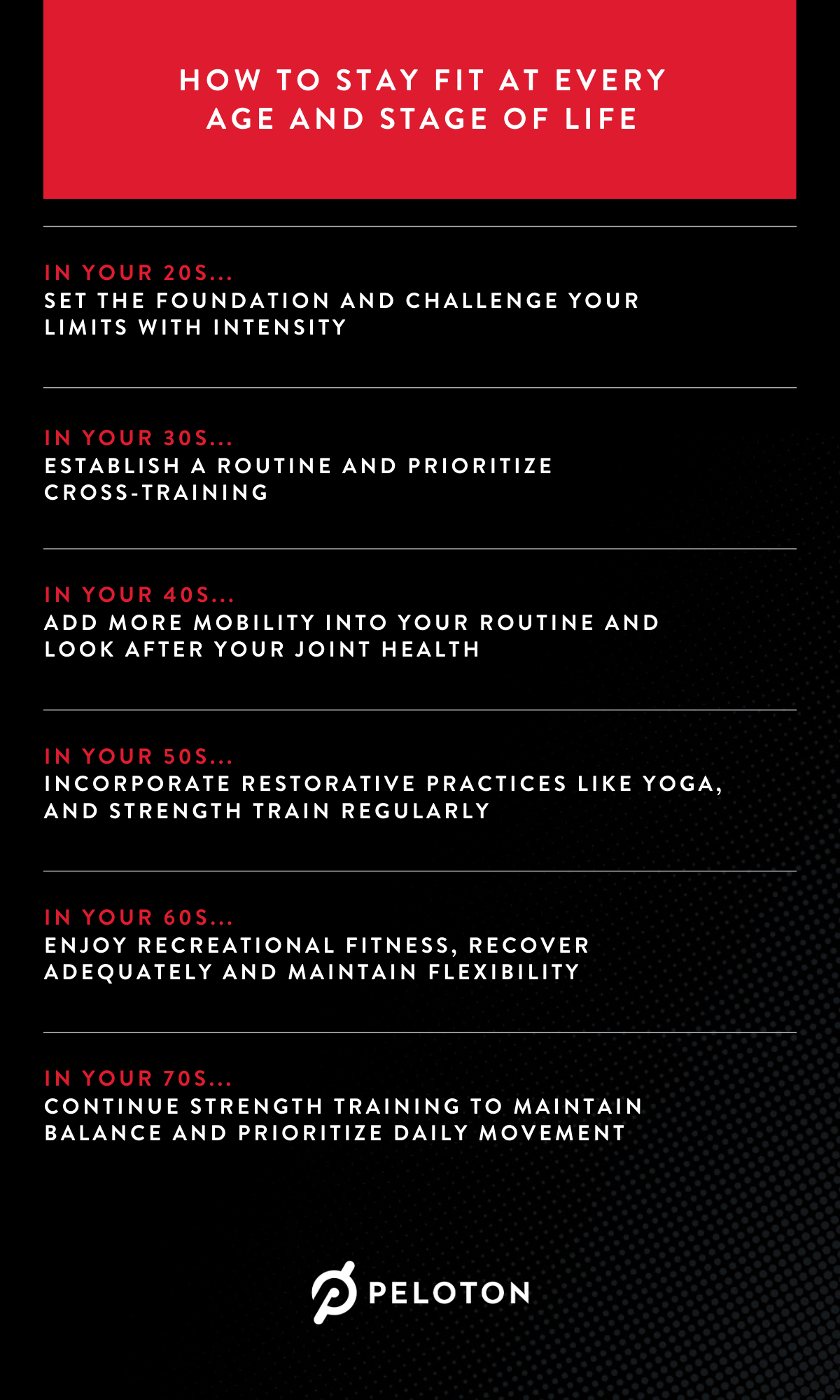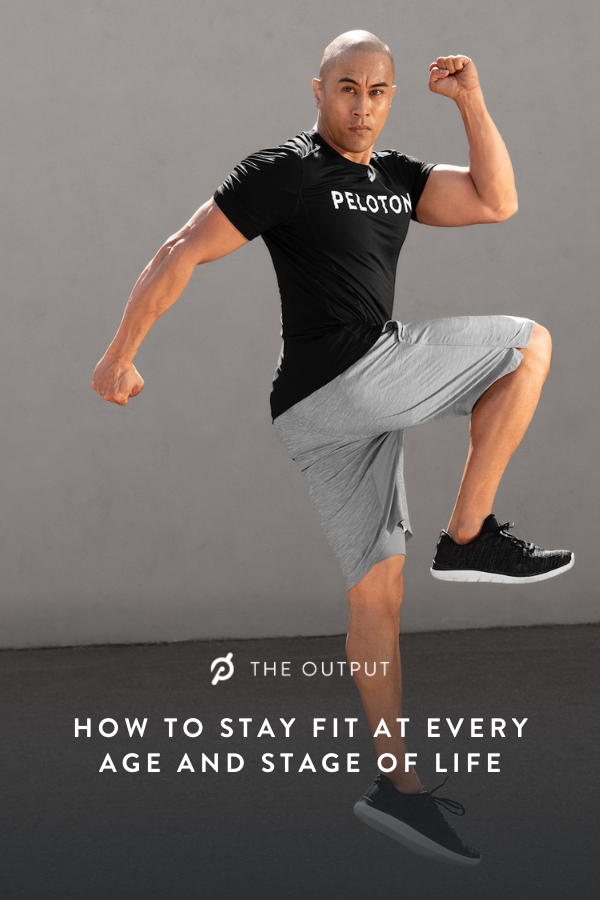
How to Stay Fit at Every Age and Stage of Life, According to Experts
You never age out of fitness. Here's how to optimize your routine throughout the decades.
By Alyssa Sybertz, Team Peloton•
How to Stay in Shape in Your 20s
How to Stay in Shape in Your 30s
How to Stay in Shape in Your 40s
How to Stay In Shape In Your 50s
How to Stay in Shape in Your 60s
How to Stay in Shape in Your 70s
The Takeaway
One of the best things about fitness: It's something you can enjoy your entire life. In 2016, an 85-year-old man completed a marathon in under four hours. Cyclist Robert Marchand set a world record by riding 14 miles in one hour at age 105. Elaine LaLanne, the first lady of fitness, still exercises for 20 minutes a day at 97, proving once and for all that 20 minutes of moderate-intensity exercise is effective.
But while age is not a limiting factor in terms of what you can achieve with fitness, it should influence how you train as you age to some degree. Here, Peloton instructors reveal how to stay in shape by adapting your training, and how these strategic shifts can set you up for lifelong health and wellness.
How to Stay in Shape in Your 20s
“Training in your 20s is about laying the foundation and fundamentals to set yourself up for health success in the long term,” says Peloton cycling instructor Sam Yo. This is the decade in which you build and strengthen your muscular, skeletal, and cardiovascular systems so that they can support you for years to come.
You’re also learning to prioritize good form while your body is naturally more mobile and flexible than it will be in later years. If you think of your body as a house, these systems (and your movement patterns) are your foundation—and the stronger they are in your 20s, the smoother your aging process will be.
“The perk of fitness in your 20s is that your body is near its peak functionality, so there are fewer limits on what the body has the ability to do,” explains Peloton cycling instructor Kendall Toole. For that reason, this is the time to push to your max intensity with high-intensity interval training (HIIT) workouts and experiment with different types of exercise to see what your body responds to best. And don’t be afraid to pick up heavy weights to improve your strength and endurance.
But while this freedom and resiliency is a strength, Kendall cautions that it can also be a weakness. “Sometimes in your 20s, you focus more on the social connections and the aesthetics and less on what your body truly needs,” she says. “But movement patterns or potential overuse issues can begin in this decade, so it’s key to start making a practice of listening to your body.” How? Kendall suggests a regimen that involves different forms of cross-training, such as cycling, running, and bootcamp classes, plus beginning to practice something more restorative, like yoga.
Also, keep an eye out for signs of overtraining, such as frequent injuries, fatigue, and poor performance. You may think you’re learning how to stay in shape by working out as hard and as often as possible, but to continue the house analogy, overtraining will cause cracks in the foundation.

How to Stay in Shape in Your 30s
“Increased levels of stress from higher-level jobs, possibly starting a family, taking on a different routine, and new priorities make the 30s where fitness routines begin to truly shift,” Kendall says. Fortunately, this is also the time when many folks start to understand their bodies better.
“You are actually stronger than you used to be, even though your metabolic rate starts to drop,” Sam says. “But mentally, you have a much better idea of what you need specifically to maintain a healthy body and mind.” If you want to stay in shape as you get older, now is the time to build on all those gains you made in your 20s—or to start making a commitment to staying active.
To maintain fitness levels and achieve goals, Kendall and Sam agree that establishing (and sticking to) an exercise routine is essential. “You might have less time to exercise because of more personal commitments, so you really need to pay attention to how you train,” Sam says. In this decade, you’ll probably mix it up between cardio and strength training for a well-rounded fitness routine. During those strength training workouts, make sure you’re focusing on choosing the right weights for your goals, whatever they may be.
In your 30s, drill down into your specific routine so that you’re able to stay consistent without mentally battling yourself each day over whether or not you’ll work out. Decide once and for all whether you prefer to work out in the morning or at night. Learn how to pack your gym bag like a pro and plan how you’ll meet your goals while you’re traveling (hint: the Peloton App is your new best friend). Planning ahead and staying motivated are key to getting fit in your 30s.

Peloton App
Access thousands of classes with no equipment needed.
To help you commit to your fitness routine, Kendall recommends setting attainable workout goals and seeking out a community that holds you accountable. “For new moms and dads, it’s a great idea to encourage your kids to join in on the workouts and create healthy, fun habits around exercise,” she says. In the meantime, continue with a mix of cross-training and restorative practices.
And if you’re finding it hard to stick to an exercise routine, consider keeping a fitness journal to log your progress and note how you feel after each workout. It’s no secret that exercise can benefit your mental health by reducing anxiety, boosting mood, and combatting depression—but seeing the effects written out may help you remember your “why.”
How to Stay in Shape in Your 40s
“At this point, it’s even more important to be consistent with your routine and utilize the spare time you have to make your workout as efficient as possible,” Sam says. Since it can become more difficult to obtain visible gains during this decade, consistently moving and challenging your body becomes more important than always pushing it to burnout. “Your metabolism slows down, and it gets harder to recruit muscle fibers,” Sam explains. “So, the body starts to thrive on less intense full-body workouts.” That might look like incorporating more Pilates, barre, and yoga into your routine so you can move daily without needing as much recovery as you would after tough HIIT workouts or heavy lifting sessions.
Speaking of lifting sessions, it’s important to continue lifting weights in your 40s. Research shows that resistance training can prevent muscle-mass loss that naturally occurs as the years go by. Resistance training can be weight training with dumbbells, of course, but you can also use resistance bands or even your body weight to get a solid strength session in.
Also key: starting to care for your joints. “Adding more mobility into your training program really helps keep your body functioning,” Sam says. Unsure what that looks like? Mobility training involves moving your joints through their full range of motion to help strengthen your body, and can include exercises like hip circles and shoulder circles.
It’s also smart to take a few extra minutes to stretch before and after your workout as well as on your off days. Using tools like a foam roller can also keep your body loose, prevent muscle soreness, improve posture and range of motion, and help you relax. (Yes, please!)
Finally, take a moment in your 40s to acknowledge how far you’ve already come in your fitness journey—and the mental toughness that brought you to where you are today. It wasn’t always easy to stay active and stick to your goals, but you’re doing it—and the best is yet to come.

How to Stay In Shape In Your 50s
When you enter your 50s, it’s important to stay dedicated to your exercise routine. “A common mistake people make at this point is to succumb to the idea that fitness is no longer for you, and that’s not the case at all!” Kendall says. “Hormonal changes are occurring in the body, and any movement pattern issues or other things that potentially limit movement have likely revealed themselves. But if you keep consistent with a restorative practice like yoga and really listen to your body, exercise in your 50s can be really exciting.”
Kendall also notes that if it’s not already, weight training becomes an even more important form of exercise to incorporate into your routine. “Strength training can significantly help with any loss in bone density and increase cardiovascular capacity,” she explains.
Just as there’s a certain freedom to training in your 20s, exercise in your 50s can be freeing, too. “The clarity of why you work out is much greater at this time,” Sam says. “What you lose physically as you get older, you gain mentally. You’re exercising purely for yourself and not to impress or uphold a superficial standard.”
So, what does that mean for staying in shape in your 50s? Get outside of your comfort zone and try a new-to-you workout, simply because you want to. Take on a meditative workout by setting an intention, focusing on your breathing, and maintaining a strong mind-body connection throughout your workout. Find the joy in moving just because, and let go of the pressure to look or perform to a certain standard. You’re too wise for that now.
How to Stay in Shape in Your 60s
“Once you reach your 60s, training can, in many ways, finally be focused on a proper balance of work and recovery and recognizing that they go hand in hand,” Kendall says. The reason: You probably know which forms of exercise your body responds to best, plus you likely have more time to commit to rest and recovery (through things like stretching and yoga), which is critical for avoiding injuries and maintaining balance and flexibility.
Any extra time earned from cutting back on work or retiring also helps—namely, you can use it to explore different forms of fitness and find a new activity you enjoy. “You can really have fun with your workouts,” notes Sam. That might mean going on day hikes, completing extended road-bike rides, or even traveling to a yoga retreat. “For folks in this decade, fitness becomes focused on wellness, knowing your body, and finding joy in movement,” Kendall says.
In this stage of life, functional strength training—which supports your everyday life and the movements you do daily—becomes crucial for aging independently and injury-free. Try prioritizing the following movements:
Squats: These will help you get up and down from chairs more easily, as well as in and out of cars.
Push-ups: Even if they’re on your knees, push-ups are incredibly functional. If you ever slip and fall, being able to push yourself up off the ground could be life-saving.
Crunches and core strength exercises: From getting out of bed to maintaining a strong posture, strengthening your core muscles will help you move more comfortably.
If you start to experience joint pain in your 60s, consider incorporating low-impact cardio like swimming, rowing, or walking. Some research has shown that swimming may improve or reduce joint pain, and a randomized control trial concluded that rowing was an effective way to improve joint health, muscle strength, and physical function in older adults with knee osteoarthritis.

How to Stay in Shape in Your 70s
“You never age out of fitness—I encourage people in their 70s to be bold and brave and know they are welcome at Peloton, too!” Kendall says. “For them, exercise should be about the relationship between physical and mental agility.” That means keeping the muscles strong with low-intensity strength training (to promote balance and avoid pain), doing weight-bearing activities like dancing or walking (to maintain healthy bone density and circulation), and enjoying rejuvenating practices like meditation (to keep the mind young). This fitness combo helps ensure that you can go about your daily life safely, with decreased risk for injury and greater freedom of movement.
Kendall also stresses the importance of at least some movement every day if you can. “As best as possible, engage in social connection while working out to make movement a part of your daily lifestyle,” she says. Like Elaine LaLanne told the New York Times, “Twenty minutes a day gets me on my way.”

The Takeaway
Learning how to stay in shape and sticking to a consistent exercise regimen can help mitigate many of the effects of aging, including (but not limited to) changes in heart rate, heart strength, blood pressure, bone and muscle strength, metabolism, sleep quality, and mental health. The result: You’ll be healthy, happy, and fit through every decade.

This content is for informational and educational purposes only and does not constitute individualized advice. It is not intended to replace professional medical evaluation, diagnosis, or treatment. Seek the advice of your physician for questions you may have regarding your health or a medical condition. If you are having a medical emergency, call your physician or 911 immediately.
Level up your inbox.
Subscribe for a weekly dose of fitness, plus the latest promos, launches, and events.
By providing your email address, you agree to receive marketing communications from Peloton.
For more about how we use your information, see our Privacy Policy.






